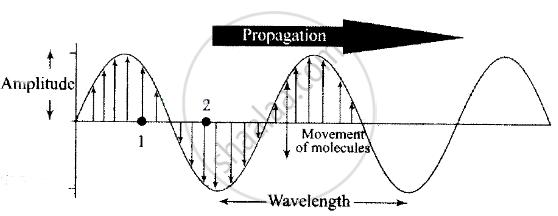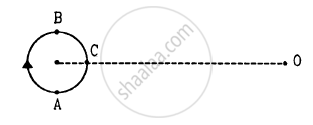Advertisements
Advertisements
Question
With propagation of longitudinal waves through a medium, the quantity transmitted is ______.
Options
matter.
energy.
energy and matter.
energy, matter and momentum.
Solution
With propagation of longitudinal waves through a medium, the quantity transmitted is energy.
Explanation:
A wave is a disturbance which propagates energy and momentum from one place to the other without the transport of matter. The propagation of longitudinal waves through a medium leads to the transmission of energy through the medium without the matter being transmitted. There is no movement of matter (mass) and hence momentum.
Important point:
Characteristics of wave motion:
- It is a sort of disturbance which travels through a medium.
- Material medium is essential for the propagation of mechanical waves.
- When a wave motion passes through a medium, particles of the medium only vibrate simply harmonically about their mean position. They do leave their position and move with the disturbance.
- There is a continuous phase difference amongst successive particles of the medium, i.e. particle 2 starts vibrating slightly later than particle 1 and so on.

- The velocity of the particle during their vibration is different at different positions.
- The velocity of wave motion through a particular medium is constant. It depends only on die nature of the medium not on the frequency, wavelength or intensity,
- Energy is, propagated along with the wave motion without any net transport of the medium.
APPEARS IN
RELATED QUESTIONS
Can you hear your own words if you are standing in a perfect vacuum? Can you hear your friend in the same conditions?
Two loudspeakers are arranged facing each other at some distance. Will a person standing behind one of the loudspeakers clearly hear the sound of the other loudspeaker or the clarity will be seriously damaged because of the 'collision' of the two sounds in between?
The bulk modulus and the density of water are greater than those of air. With this much of information, we can say that velocity of sound in air
A tuning fork of frequency 512 Hz is vibrated with a sonometer wire and 6 beats per second are heard. The beat frequency reduces if the tension in the string is slightly increased. The original frequency of vibration of the string is
A small source of sounds moves on a circle as shown in figure and an observer is sitting at O. Let \[v_1, v_2, v_3\] be the frequencies heard when the source is at A, B and C respectively.

A person can hear sound waves in the frequency range 20 Hz to 20 kHz. Find the minimum and the maximum wavelengths of sound that is audible to the person. The speed of sound is 360 m s−1.
A sources of sound operates at 2.0 kHz, 20 W emitting sound uniformly in all directions. The speed of sound in air is 340 m s−1 and the density of air is 1.2 kg m −3. (a) What is the intensity at a distance of 6.0 m from the source? (b) What will be the pressure amplitude at this point? (c) What will be the displacement amplitude at this point?
The separation between a node and the next antinode in a vibrating air column is 25 cm. If the speed of sound in air is 340 m s−1, find the frequency of vibration of the air column.
The first overtone frequency of a closed organ pipe P1 is equal to the fundamental frequency of a open organ pipe P2. If the length of the pipe P1 is 30 cm, what will be the length of P2?
A source of sound with adjustable frequency produces 2 beats per second with a tuning fork when its frequency is either 476 Hz of 480 Hz. What is the frequency of the tuning fork?
